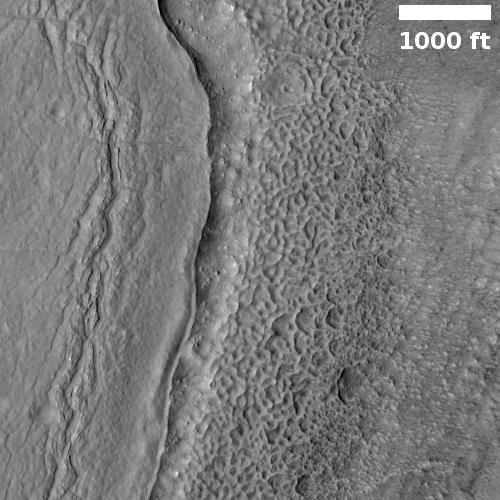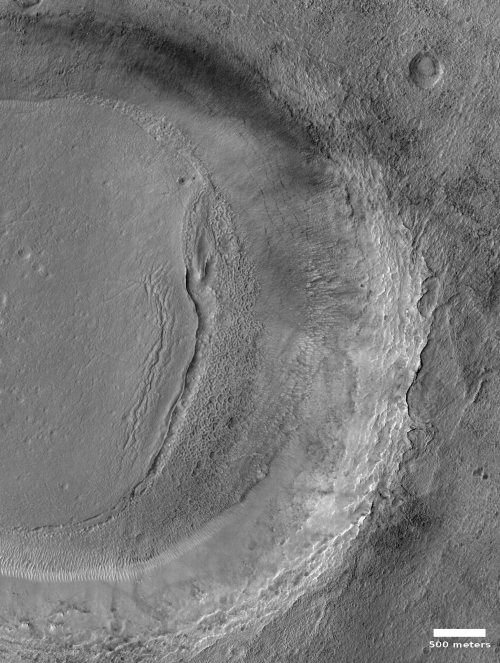Ice-filled crater on Mars?
Time for another of the many cool images from Mars that suggest the presence of buried glacial ice. The photo to the right, rotated, cropped, and reduced to post here, shows an unnamed crater in the cratered southern highlands of Mars at about 44 degrees south latitude. Taken on October 2, 2020 by the high resolution camera on Mars Reconnaissance Orbiter (MRO), the crater sits at the very southernmost point of the Tharsis Bulge where the Red Planet’s four more distinctive giant volcanoes are located.
The crater is also in the middle of the 30 to 60 degree mid-latitude bands where scientists have detected many features that suggest glaciers, including a large number of craters that appear to have ice filling their interior.
Does the material in this crater’s floor suggest eroding and sublimating ice to you? It does to me. The second image below zooms in at full resolution at the north-south trench and the strange patterned terrain to its east.

I suspect this crater would fall into the concentric-crater-filled category, which is the label scientists have given craters that appear to be filled with glacial ice. The trench and the patterned material invoke to my eye the edge of the glacier, with the patterned material the most eroded of all. That patterned material also invokes one of Mars’s strangest geological features dubbed brain terrain.
Though scientists remain unsure the process that forms brain terrain, they presently think it might be related to the sublimation of underground ice. When the ice turns to gas, it breaks out at weak points, causing the random depressions between the knobs. If this is glacial material, covered with dust and debris to mostly protect it, that theory fits.
Interestingly, I posted a different cool image of a crater in August showing similar brain terrain on its floor that also happens to be only about 100 miles north of this crater. Same latitude, similar features inside a crater. Sure suggests there is a lot of somewhat accessible ice on Mars.
On Christmas Eve 1968 three Americans became the first humans to visit another world. What they did to celebrate was unexpected and profound, and will be remembered throughout all human history. Genesis: the Story of Apollo 8, Robert Zimmerman's classic history of humanity's first journey to another world, tells that story, and it is now available as both an ebook and an audiobook, both with a foreword by Valerie Anders and a new introduction by Robert Zimmerman.
The print edition can be purchased at Amazon or from any other book seller. If you want an autographed copy the price is $60 for the hardback and $45 for the paperback, plus $8 shipping for each. Go here for purchasing details. The ebook is available everywhere for $5.99 (before discount) at amazon, or direct from my ebook publisher, ebookit. If you buy it from ebookit you don't support the big tech companies and the author gets a bigger cut much sooner.
The audiobook is also available at all these vendors, and is also free with a 30-day trial membership to Audible.
"Not simply about one mission, [Genesis] is also the history of America's quest for the moon... Zimmerman has done a masterful job of tying disparate events together into a solid account of one of America's greatest human triumphs."--San Antonio Express-News
Time for another of the many cool images from Mars that suggest the presence of buried glacial ice. The photo to the right, rotated, cropped, and reduced to post here, shows an unnamed crater in the cratered southern highlands of Mars at about 44 degrees south latitude. Taken on October 2, 2020 by the high resolution camera on Mars Reconnaissance Orbiter (MRO), the crater sits at the very southernmost point of the Tharsis Bulge where the Red Planet’s four more distinctive giant volcanoes are located.
The crater is also in the middle of the 30 to 60 degree mid-latitude bands where scientists have detected many features that suggest glaciers, including a large number of craters that appear to have ice filling their interior.
Does the material in this crater’s floor suggest eroding and sublimating ice to you? It does to me. The second image below zooms in at full resolution at the north-south trench and the strange patterned terrain to its east.

I suspect this crater would fall into the concentric-crater-filled category, which is the label scientists have given craters that appear to be filled with glacial ice. The trench and the patterned material invoke to my eye the edge of the glacier, with the patterned material the most eroded of all. That patterned material also invokes one of Mars’s strangest geological features dubbed brain terrain.
Though scientists remain unsure the process that forms brain terrain, they presently think it might be related to the sublimation of underground ice. When the ice turns to gas, it breaks out at weak points, causing the random depressions between the knobs. If this is glacial material, covered with dust and debris to mostly protect it, that theory fits.
Interestingly, I posted a different cool image of a crater in August showing similar brain terrain on its floor that also happens to be only about 100 miles north of this crater. Same latitude, similar features inside a crater. Sure suggests there is a lot of somewhat accessible ice on Mars.
On Christmas Eve 1968 three Americans became the first humans to visit another world. What they did to celebrate was unexpected and profound, and will be remembered throughout all human history. Genesis: the Story of Apollo 8, Robert Zimmerman's classic history of humanity's first journey to another world, tells that story, and it is now available as both an ebook and an audiobook, both with a foreword by Valerie Anders and a new introduction by Robert Zimmerman.
The print edition can be purchased at Amazon or from any other book seller. If you want an autographed copy the price is $60 for the hardback and $45 for the paperback, plus $8 shipping for each. Go here for purchasing details. The ebook is available everywhere for $5.99 (before discount) at amazon, or direct from my ebook publisher, ebookit. If you buy it from ebookit you don't support the big tech companies and the author gets a bigger cut much sooner.
The audiobook is also available at all these vendors, and is also free with a 30-day trial membership to Audible.
"Not simply about one mission, [Genesis] is also the history of America's quest for the moon... Zimmerman has done a masterful job of tying disparate events together into a solid account of one of America's greatest human triumphs."--San Antonio Express-News


